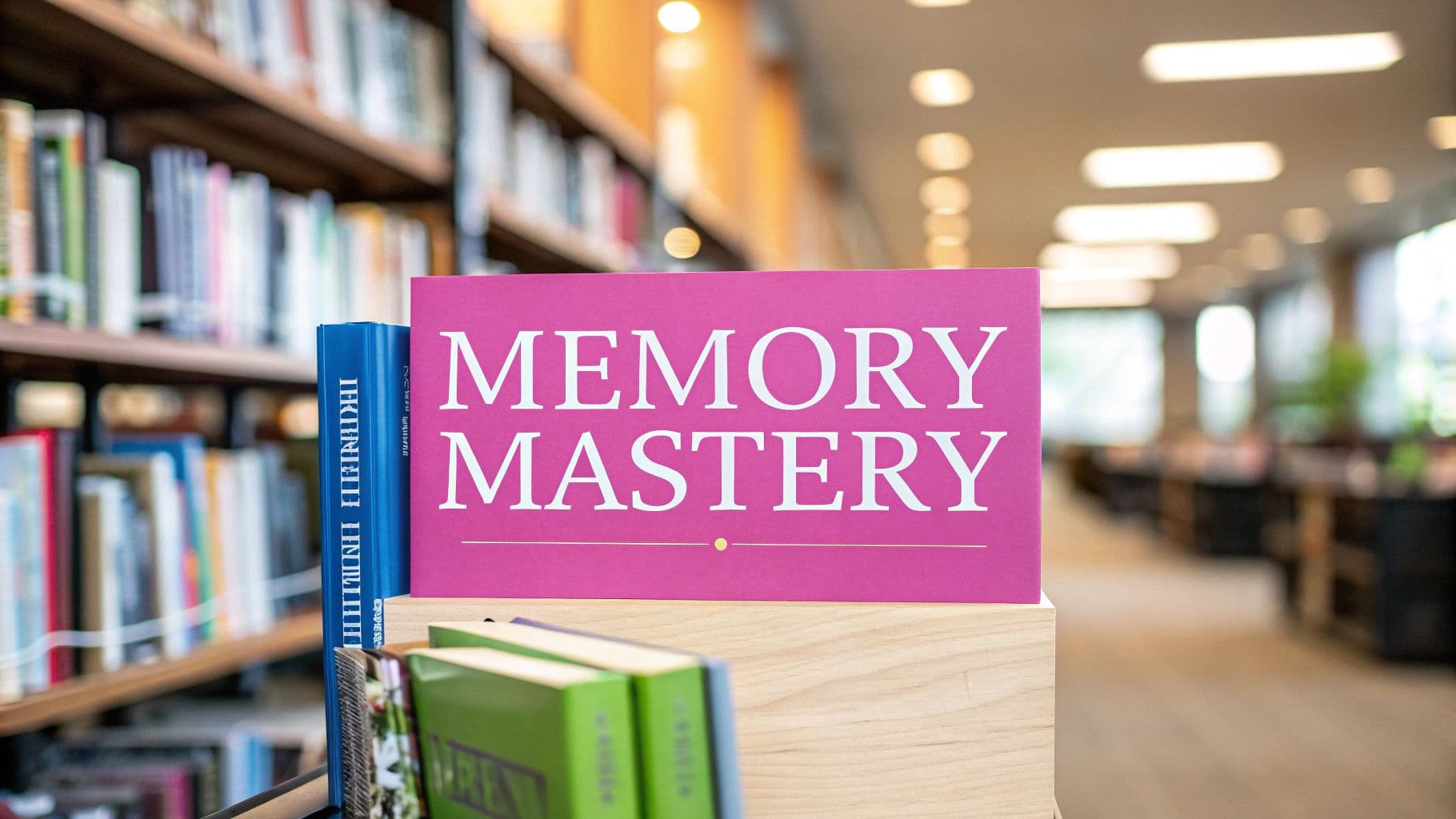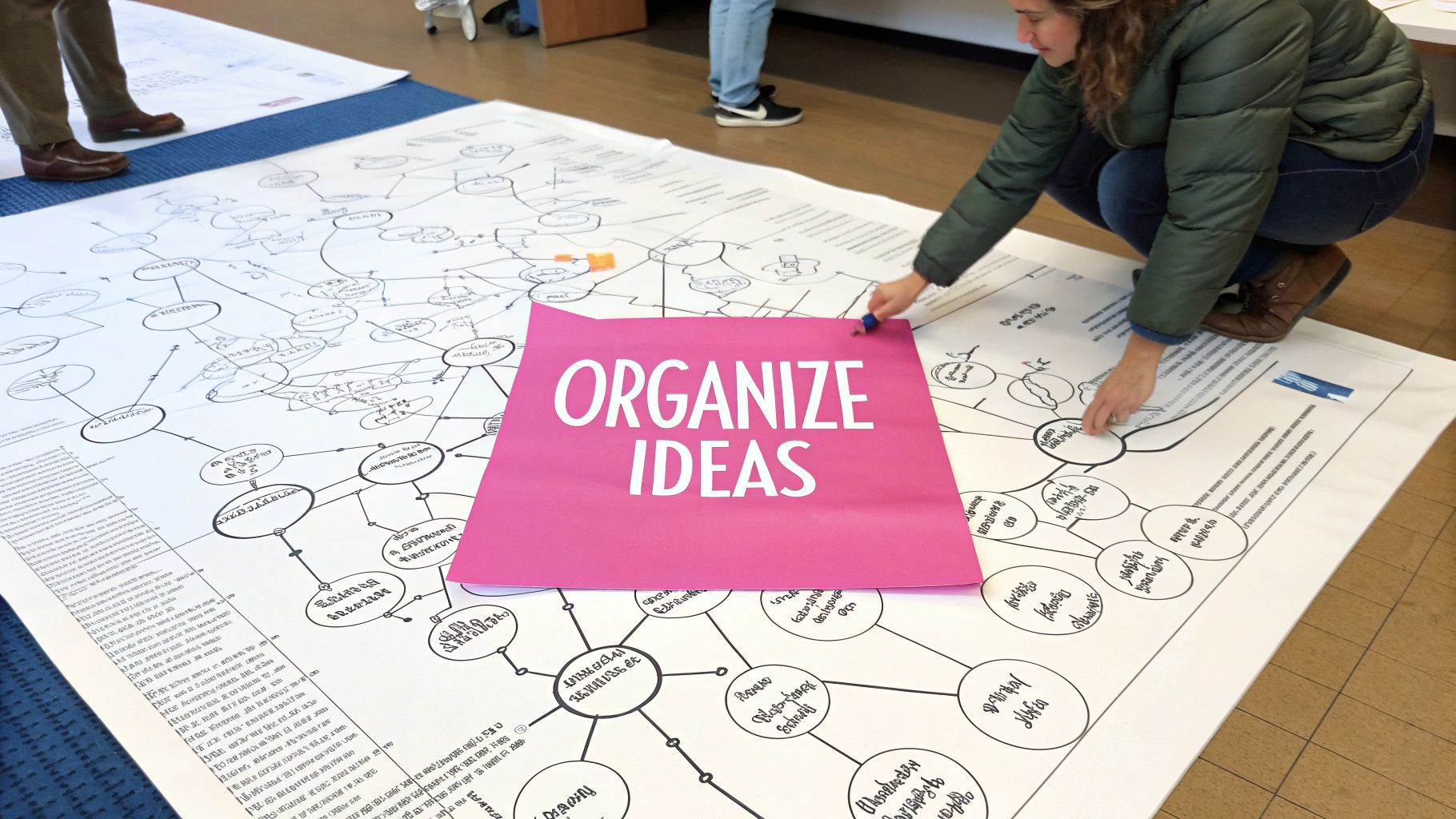
How to Remember What You Read: Step-by-Step Memory Techniques That Actually Work
Understanding How Your Brain Processes Reading
The process of reading involves far more than recognizing words – it requires multiple regions of your brain working in concert to decode, make sense of, and store information. When you grasp how this process works, you can better understand why certain details stick in your memory while others fade away. This knowledge gives you the tools to read more effectively and retain what matters most.
Deconstructing the Reading Process
As your eyes scan text, visual signals travel to the occipital lobe at the back of your brain, which processes what you're seeing. From there, the information moves to Wernicke's area in the left temporal lobe – a crucial region for language comprehension that breaks down sentences into meaningful chunks. But simply decoding words isn't enough to create lasting memories of what you've read.
The Role of Active Engagement
To move information from short-term to long-term memory, you need to actively engage with the material rather than passively absorbing it. Think of it like building a bridge – passive reading is just looking at the blueprints, while active engagement means doing the actual construction work piece by piece. For example, if you read about exercise benefits, don't just skim the information. Instead, connect it to your own fitness goals, picture yourself doing the exercises, or sketch out a workout plan. This hands-on mental involvement strengthens the neural pathways that help you remember what you learned.
Memory Consolidation: Why Some Information Sticks
Deep in your brain, the hippocampus acts like a temporary filing system, processing new information before sending it to long-term storage. Research shows that working memory – your ability to hold and process information – accounts for about 7% of reading comprehension. This means the better you can actively connect ideas while reading, the more likely they are to stick. Short-term memory contributes another 4%, highlighting why you need strategies to bridge the gap between initial understanding and lasting retention. Think of it like organizing files – information that's well-categorized and connected is much easier to find later than scattered, unrelated facts.
Making Connections: The Power of Context
Your brain naturally remembers information better when it connects to things you already know or have experienced. This is why analogies and examples work so well – they give you familiar frameworks for understanding complex ideas. For instance, grasping the scale of space is challenging on its own. But comparing Earth to a marble and the sun to a beach ball makes the concept more tangible and memorable. When you actively look for connections between new information and your existing knowledge, you significantly boost retention. You might link historical events to current politics, connect scientific concepts to personal experiences, or visualize information in meaningful ways. These mental bridges create richer, more lasting memories. By understanding these core processes of how your brain handles information, you can develop better reading strategies that help you retain and use what you learn.
Choosing Your Reading Environment for Maximum Retention

The environment where you read has a direct impact on how well your brain processes and remembers information. Setting up an ideal reading space isn't just about comfort – it's essential for retaining what you read. By understanding key factors like format choice and minimizing distractions, you can create conditions that help information stick in your memory.
The Great Debate: Print vs. Digital
When it comes to remembering what you read, the choice between print and digital formats matters more than you might think. Research shows that printed materials often lead to better comprehension and recall, especially for longer texts. This is partly because physical books provide helpful spatial landmarks – you can remember information based on where it appeared on the page or how far into the book it was. The simple act of turning pages also helps cement information in your memory through physical engagement with the text.
Digital formats have their own advantages though. Features like searchable text, built-in dictionaries, and adjustable font sizes can be especially helpful for readers with visual impairments or those learning new languages. While print books may have an edge for retention overall, digital reading can work better for certain people and types of material. The key is matching the format to your specific needs and the type of text you're reading.
Creating a Distraction-Free Zone
No matter which format you choose, managing distractions is crucial. Our brains simply aren't wired to multitask effectively. Even quick interruptions can derail our focus and interfere with forming new memories. Finding a quiet space where you can concentrate makes a big difference in how much information you retain. Turn off phone notifications, silence devices, and let others know you need uninterrupted reading time. Small distractions like background music or TV noise can fragment your attention more than you realize.
Optimizing Your Physical Space
The physical setup of your reading environment also affects how well you process information. Good lighting prevents eye strain that can break your concentration. A comfortable but supportive seat helps you maintain focus longer. Room temperature and fresh air matter too – a slightly cool, well-ventilated space typically keeps you more alert than a warm, stuffy room. When you optimize these environmental factors, you create ideal conditions for engaging deeply with the text and strengthening your memory of what you read. Taking time to set up a proper reading environment is an investment that pays off in better comprehension and recall.
Making Information Stick Through Active Engagement

While having the right reading environment and format are essential first steps, the real secret to remembering what you read comes from engaging actively with the text. Simply reading passively won't help information stick in your memory – you need to work with the content deliberately and thoughtfully. Let's explore some proven techniques that can help you interact with text more effectively and retain more of what you learn.
Beyond Highlighting: Annotation Methods That Work
Although highlighting key passages is common, it only becomes truly useful when combined with deeper engagement. Here are some effective annotation strategies to try:
- Summarizing and Paraphrasing: After highlighting important sections, write brief summaries in your own words. This helps you process the information more thoroughly and verify your understanding.
- Asking Questions: Write down questions that come to mind as you read. This promotes critical thinking and helps identify concepts that need more clarity.
- Making Connections: Connect highlighted passages to other things you've learned, either from the same text or other sources. Building these knowledge connections strengthens memory.
For instance, if you're reading about exercise benefits, don't just highlight the list. Instead, note how each benefit connects to your personal fitness goals or link them to scientific concepts you already understand. This active processing helps cement the information in your memory in a meaningful way.
The Power of Selective Vocalization
Research shows that reading aloud can significantly improve memory recall, particularly for short texts or complex material. While reading an entire book out loud isn't practical, strategic vocalization can be very effective:
- Read Key Concepts Aloud: Choose the most important sentences or paragraphs to read out loud. This helps anchor these core ideas in your memory.
- Explain Concepts to Someone Else: Teaching what you've read to another person requires deep understanding and strengthens your own recall. This technique works especially well for remembering complex material.
This means you can use vocalization selectively to reinforce specific information you want to remember, without spending excessive time reading everything aloud.
Developing a Personalized Engagement System
Different types of reading material call for different levels of engagement. A casual novel doesn't need the same intensive processing as a scientific paper. Here's how to adjust your approach:
- Technical Material: Use detailed annotations, selective reading aloud, and regular breaks to process complex information.
- Narrative Texts: Focus on creating mental images, connecting with characters, and thinking about major themes.
- Non-Fiction Books: Combine highlighting with summaries, questions, and connections to what you already know. Consider creating notes or mind maps to organize main ideas.
By matching your engagement strategy to the type of material, you can remember more without getting overwhelmed by excessive note-taking.
Consider your natural learning preferences when building your system. Some people learn best through visual aids, while others prefer listening or hands-on methods. Try different approaches – like drawing diagrams, using audiobooks, or acting out concepts – to find what works best for you. The goal is to make learning both effective and memorable.
Transforming Complex Content Into Memorable Stories
Our brains are naturally wired to remember stories better than isolated facts. Think about how easily you recall the plot of your favorite movie compared to memorizing a list of information. Stories create meaningful connections between pieces of information in our minds, giving us a powerful framework for learning and retention. By converting complex content into narrative form, we can boost our ability to remember what we read.
Weaving Information into Narrative Threads
The key is to identify the basic elements that make any good story engaging – characters, conflict, resolution, and a clear narrative flow. Even technical or academic content can be reframed this way. Take the discovery of penicillin as an example: Instead of just memorizing facts and dates, envision Alexander Fleming as the protagonist facing the widespread challenge of bacterial infections. His accidental but insightful discovery becomes the climactic resolution that changed medical history.
Practical Exercises for Narrative Transformation
This storytelling approach works well for any type of content, from non-fiction books to business reports. A company's marketing campaign becomes a story of overcoming market challenges to achieve growth goals. Here are specific ways to transform complex information into memorable narratives:
- Identify Key Players: Pick out the main people, organizations, or concepts involved that can serve as your "characters"
- Define the Conflict: Pinpoint the core problem or challenge being addressed
- Trace the Resolution: Map out how the situation was resolved and what key events led there
- Craft a Narrative Arc: Arrange information chronologically to build tension and reach a satisfying conclusion
Why Stories Stick: The Science Behind Narrative Memory
Research supports the power of narrative-based learning. Studies show that people remember information much better when it's presented as a story rather than as disconnected facts. This is because stories engage multiple brain regions simultaneously and create richer neural connections. The emotional elements in stories also strengthen memory formation – research participants consistently recalled more details from emotionally engaging narratives compared to neutral ones. By thoughtfully converting information into story form, we move beyond basic memorization to develop deeper, more lasting understanding of what we read.
Building Your Reading Memory Muscle

Just like regular exercise builds physical strength, consistent reading practice strengthens your ability to retain information. The key is developing solid habits and techniques that help you absorb and remember what you read. Rather than trying to cram information quickly, focus on building lasting knowledge through steady, deliberate practice.
Creating a Sustainable Reading Habit
Think of building your reading memory like training for a long race – you need to start slowly and build up gradually. Begin with shorter articles or book chapters that you can comfortably process. As you gain confidence, work up to longer and more complex texts. This measured approach helps your brain adapt and develop the mental stamina needed for better retention. By avoiding overwhelming yourself early on, you'll maintain enthusiasm and see steady progress in your reading skills.
Tracking Progress and Staying Motivated
Keep tabs on your reading development by maintaining a simple journal. After each reading session, write down key points and major takeaways. Test yourself a few days later to check how much you remember – this helps cement the information in your memory. Don't get discouraged if you sometimes struggle to recall details. Like any skill, reading retention improves with time and practice. Focus on celebrating small wins as you make progress.
Gradual Exposure to Challenging Material
Once you're comfortable with your current reading level, begin incorporating more complex texts into your routine. Try academic papers, technical documents, or classic literature that stretches your abilities. Just as you'd gradually increase weights at the gym, challenging yourself with harder material builds your cognitive strength over time. The key is finding the right balance – push yourself enough to grow, but not so much that you feel overwhelmed.
Incorporating Active Recall Techniques
One of the most effective ways to remember what you read is through active recall – deliberately trying to retrieve information from memory. After finishing a section, close the book and summarize the main ideas in your own words. Creating flashcards or using spaced repetition helps reinforce key concepts. Like building physical muscle through repeated exercise, regularly practicing active recall strengthens your ability to remember and access information.
Personalizing Your Retention Strategy
Everyone processes information differently, so experiment to find what works best for you. You might prefer creating visual maps, drawing diagrams, or even acting out concepts to help them stick. Pay attention to which methods help you retain information most effectively and make those techniques a regular part of your reading practice. When you develop an approach that matches your learning style, reading becomes an engaging process of building lasting knowledge rather than just passive consumption of information.
Advanced Retention Strategies for Challenging Materials
When dealing with complex reading material, basic techniques aren't always enough. Let's explore proven strategies that top performers use to master and retain challenging information. These methods transform the process of remembering what you read from a struggle into a systematic approach.
Deconstructing Complex Information
When facing dense, interconnected concepts, breaking them down systematically is essential. The Feynman Technique is particularly effective – try explaining the concept as if teaching it to a beginner. This process naturally reveals gaps in your understanding and shows you exactly what areas need more review. Visual aids like mind maps can also help map relationships between ideas. For instance, when studying a biological process, sketching out the key steps in a simple flowchart makes the sequence more concrete and memorable.
Building Bridges Between Concepts
Connecting new information to your existing knowledge creates stronger, more lasting memories. Think of your memory as an intricate web – the more connections you create between pieces of information, the easier they are to recall later. When you encounter new material, actively ask yourself: How does this relate to concepts I already understand? What parallels can I draw to other subjects? This deliberate linking strengthens memory pathways, especially for academic or technical content.
Managing Information Overload
Complex texts often present an overwhelming amount of information. To handle this effectively, use spaced repetition – reviewing material at gradually increasing intervals to take advantage of how memory consolidation works. Additionally, focus on identifying and mastering core concepts rather than trying to memorize every detail. When reading a scientific paper, for example, concentrate on understanding the key methodology and findings rather than memorizing minor details. This targeted approach prevents mental fatigue and helps you retain what matters most.
Cultivating Metacognitive Awareness
Understanding how you think and learn is crucial for improving retention. Pay attention to what helps you grasp concepts and what makes certain material challenging. Ask yourself questions like "What study methods are working best for me?" and "Where am I getting stuck?" This self-awareness helps you adjust your approach based on what works. For example, if you notice you struggle with long, dense paragraphs, try breaking them into smaller chunks and summarizing each section in your own words.
Transform your study sessions from passive reading to dynamic learning experiences with Notescast! This innovative app uses AI to transform your notes and study materials into engaging video content. Say goodbye to monotonous reading and hello to addictive learning. Check out Notescast today and experience the future of studying: https://notescast.app/
